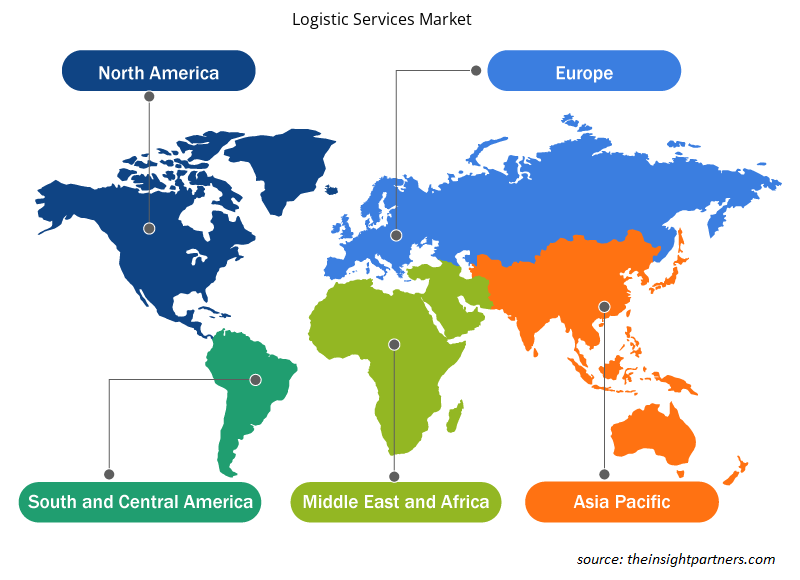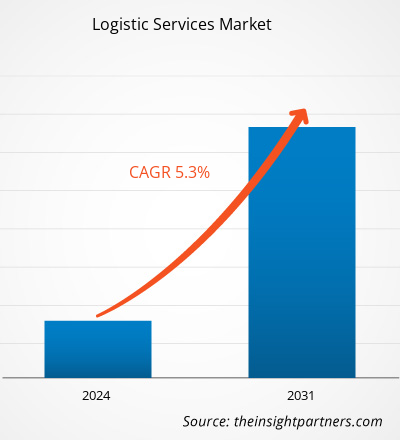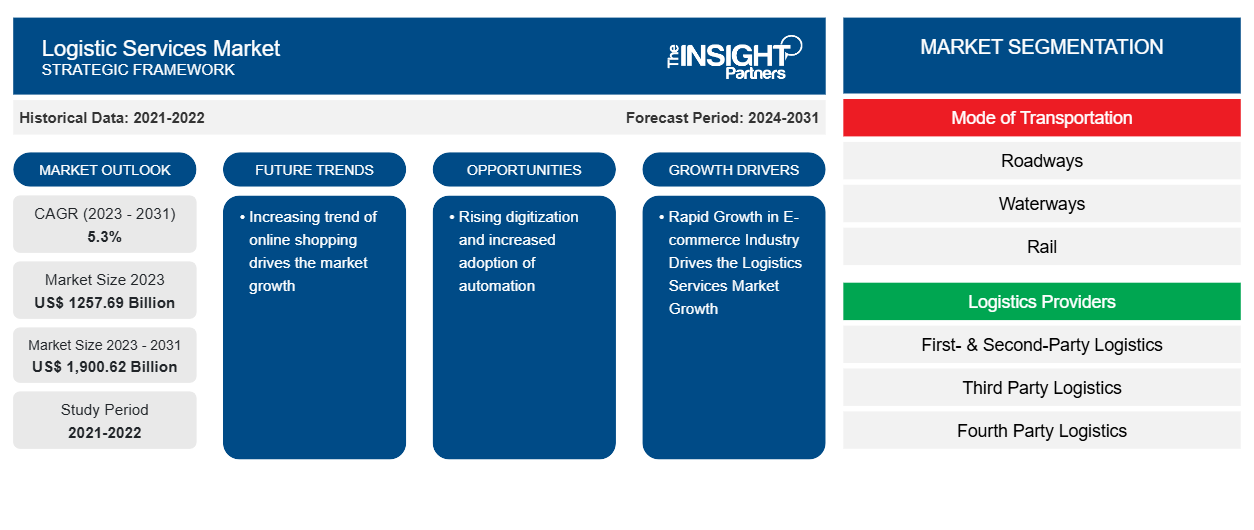物流サービス市場規模は、2023年の1兆2,576億9,000万米ドルから2031年には1兆9,006億2,000万米ドルに達すると予測されています。市場は2023年から2031年にかけて5.3%のCAGRを記録すると予想されています。運用コストを削減するためにサプライチェーンプロセスを改善した物流サービス業務のアウトソーシングの需要が高まっているため、物流サービス市場の成長に対する大きな需要が生まれています。また、サードパーティロジスティクスおよびフォースパーティロジスティクスプロバイダーの採用が増えていることから、物流サービス市場の需要が世界的に高まっています。現在、主要な物流プロバイダーには、貨物運送業者、貨物管理会社、物流コンサルティング会社、在庫および保管管理サービスプロバイダー、サプライチェーンコンサルタントなどが含まれます。
また、物流会社による高度な技術に基づくテレマティクス ソリューションの採用の増加も、市場の成長を牽引しています。物流サービスでは、リアルタイム追跡、荷物の追跡と監視などのさまざまな操作が提供され、倉庫計画が物流サービス市場の成長を牽引すると予想されています。世界の物流サービス市場は、e コマース業界の急速な進歩の急増により、非常に細分化されています。
物流サービス市場分析
物流サービスには、ファーストパーティロジスティクスプロバイダーとセカンドパーティロジスティクスプロバイダー、サードパーティロジスティクス (3PL)、フォースパーティロジスティクス、フィフスパーティロジスティクスが含まれます。物流サービスは、サプライチェーン管理の重要な部分です。フォースパーティロジスティクスサービスは、製品を最終顧客に届け、利益率を高めます。物流サービスには、工場から最終消費者への商品の配送からサプライチェーンのすべての要素が含まれます。これらは、メーカーから倉庫、倉庫から販売店への商品の輸送、顧客の注文履行、エンドユーザーへの配送で構成されます。3PL は、注文履行の一環としてすべての物流サービスを促進します。物流サービスには、工場から履行倉庫への輸送、倉庫での注文履行、出荷、顧客からの注文および顧客への注文の配送が含まれます。
物流サービス市場の概要
物流サービス輸送には、航空、鉄道、水路、道路輸送が含まれます。これらのうち、2023年には道路輸送が最大のシェアを占めますが、これは世界レベルで電子商取引業界の急速な導入が進んでいるためです。また、水路輸送には、河川、湖、運河、沿岸水域を通る貨物や乗客の移動が含まれます。水上輸送は、大量の貨物を長距離輸送するのに費用対効果が高く、道路や航空に比べて高い柱積載能力を備えています。世界中で輸出入活動が急増するグローバル化における急速な工業化の成長は、予測期間中の物流サービス市場の成長の主な原動力です。このような要因が、予測期間中の物流サービス市場の成長を牽引しています。
要件に合わせてレポートをカスタマイズする
このレポートの一部、国レベルの分析、Excelデータパックなど、あらゆるレポートを無料でカスタマイズできます。また、スタートアップや大学向けのお得なオファーや割引もご利用いただけます。
-
このレポートの主要な市場動向を入手してください。この無料サンプルには、市場動向から見積もりや予測に至るまでのデータ分析が含まれます。
物流サービス市場の推進要因と機会
電子商取引業界の急速な成長が物流サービス市場の成長を牽引
電子商取引部門は、主に物流サービスに依存して、最終顧客への商品配送を管理しています。世界中でオンラインショッピングの需要が高まり、インターネットが世界中で急速に普及していることは、予測期間中の物流サービス市場の成長を促進する主な要因です。米国の電子商取引業界の売上高は、2023年に約1兆1,190億米ドルに達し、2022年の1兆300億米ドルと比較して7.6%増加しました。一方、小売電子商取引の売上高は、2023年に5兆880億米ドルに達し、2022年の4兆9,040億米ドルと比較して3.8%増加しました。世界中の電子商取引消費者の増加による電子商取引業界の急速な成長は、予測期間中の物流サービス市場の成長を牽引します。電子商取引部門の継続的な拡大に伴い、ラストマイル配送物流サービスの需要も増加しました。物流サービス市場の成長を牽引する主要セクターには、小売、医薬品、食品・飲料が含まれます。さらに、動きの速い消費財セクターの製品も、予測期間中の物流サービス市場の成長に大きく貢献しています。
デジタル化の進展と自動化の導入増加
物流部門は、製造部門のサプライ チェーンの管理を担当しています。これには、商品、サービス、関連製品の輸送が含まれます。物流業界は、急速なデジタル化と自動化の導入により、大きな需要に直面しています。物流サービス プロバイダーは、物流業務を合理化し、輸送効率を向上させるために、人工知能、モノのインターネット (IoT)、機械学習、ロボットなどのテクノロジをますます採用しています。これには、倉庫の自動化、ロボットの実装、予測分析、自律走行車などが含まれます。
物流サービス市場レポートのセグメンテーション分析
物流サービス市場分析の導出に貢献した主要なセグメントは、タイプ、プラットフォーム、アプリケーション、およびエンドユーザーです。
- 輸送モードに基づいて、世界の物流サービス市場は、道路、水路、鉄道、航空に分かれています。
- 物流プロバイダーに基づいて、市場はファーストパーティロジスティクス、セカンドパーティロジスティクス、サードパーティロジスティクス、フォースパーティロジスティクス、フィフスパーティロジスティクスに分類されます。
- エンドユーザーに基づいて、世界の物流サービス市場は、政府および公共事業、ヘルスケア、工業製造、小売および消費財、航空宇宙および防衛、その他に分類されます。
地域別物流サービス市場シェア分析
物流サービス市場レポートの地理的範囲は、主に北米、ヨーロッパ、アジア太平洋、中東およびアフリカ、南米の 5 つの地域に分かれています。
北米の物流サービス市場は、最大のシェアを占めると予想されており、予測期間中に急速に成長しています。主に物流サービス業界は、電子商取引業界の成長の加速により急速に成長しています。米国やカナダなどの国には、UPS、FedEx、DHL、CH Robinsonなどの主要な物流サービスプロバイダーが多数存在しています。この地域は、米国・メキシコ・カナダ協定(USMCA)によって促進された高度な貿易活動により、大きな需要を獲得しました。さらに、この地域には、人工知能、ビッグデータ、クラウドコンピューティング、モノのインターネットなどのいくつかの高度なテクノロジーも存在しています。
物流サービス市場の地域別分析
予測期間を通じて物流サービス市場に影響を与える地域的な傾向と要因は、Insight Partners のアナリストによって徹底的に説明されています。このセクションでは、北米、ヨーロッパ、アジア太平洋、中東、アフリカ、南米、中米にわたる物流サービス市場のセグメントと地理についても説明します。

- 物流サービス市場の地域別データを入手
物流サービス市場レポートの範囲
| レポート属性 | 詳細 |
|---|---|
| 2023年の市場規模 | 12576.9億米ドル |
| 2031年までの市場規模 | 1兆9,006億2,000万米ドル |
| 世界のCAGR(2023年~2031年) | 5.3% |
| 履歴データ | 2021-2022 |
| 予測期間 | 2024-2031 |
| 対象セグメント |
交通手段別
|
| 対象地域と国 |
北米
|
| 市場リーダーと主要企業プロフィール |
|
物流サービス市場のプレーヤー密度:ビジネスダイナミクスへの影響を理解する
物流サービス市場は、消費者の嗜好の変化、技術の進歩、製品の利点に対する認識の高まりなどの要因により、エンドユーザーの需要が高まり、急速に成長しています。需要が高まるにつれて、企業は提供内容を拡大し、消費者のニーズを満たすために革新し、新たなトレンドを活用し、市場の成長をさらに促進しています。
市場プレーヤー密度とは、特定の市場または業界内で活動している企業または会社の分布を指します。これは、特定の市場スペースに、その規模または総市場価値と比較して、どれだけの競合相手 (市場プレーヤー) が存在するかを示します。
物流サービス市場で事業を展開している主要企業は次のとおりです。
- CHロビンソン
- DBシェンカーロジスティクス
- ユナイテッド・パーセル・サービス
- エクスペディターズインターナショナル
- ジオディスロジスティック
- 日本通運
免責事項:上記の企業は、特定の順序でランク付けされていません。

- 物流サービス市場のトップキープレーヤーの概要を入手
物流サービス市場のニュースと最近の動向
物流サービス市場は、主要な企業出版物、協会データ、データベースなどの一次調査と二次調査後の定性的および定量的データを収集することによって評価されます。以下は、物流サービス市場の動向と戦略のリストです。
- 2023年1月、Amazon.com Inc.はインドで航空貨物フリートサービスであるAmazon Airを開始しました。このサービスは、増大するeコマース分野の需要を満たすために開始されました。このeコマース企業は、荷物の配達を迅速化することを目的として、インドのベンガルール市に拠点を置く航空貨物サービスプロバイダー企業であるQuikjetと提携しました。(出典:DJI、プレスリリース/企業ウェブサイト/ニュースレター)
- 物流会社AP Moller-Merksは2023年3月、デンマークのビルンと中国の杭州間の航空貨物サービスを開始しました。この新しい物流サービスは、高まる顧客需要に応えるために開始されました。(出典:Flyability、プレスリリース/企業ウェブサイト/ニュースレター)
物流サービス市場レポートの対象範囲と成果物
「物流サービス市場の規模と予測(2021〜2031年)」レポートでは、以下の分野をカバーする市場の詳細な分析を提供しています。
- 対象範囲に含まれるすべての主要市場セグメントの世界、地域、国レベルでの市場規模と予測
- 市場の動向(推進要因、制約、主要な機会など)
- 今後の主な動向
- 詳細なPEST分析
- 主要な市場動向、主要プレーヤー、規制、最近の市場動向を網羅した世界および地域の市場分析
- 市場集中、ヒートマップ分析、主要プレーヤー、最近の動向を網羅した業界の状況と競争分析
- SWOT分析による詳細な企業プロフィール
- 過去2年間の分析、基準年、CAGRによる予測(7年間)
- PEST分析とSWOT分析
- 市場規模価値/数量 - 世界、地域、国
- 業界と競争環境
- Excel データセット
最新レポート
関連レポート
お客様の声
購入理由
- 情報に基づいた意思決定
- 市場動向の理解
- 競合分析
- 顧客インサイト
- 市場予測
- リスク軽減
- 戦略計画
- 投資の正当性
- 新興市場の特定
- マーケティング戦略の強化
- 業務効率の向上
- 規制動向への対応























 無料サンプルを入手 - 物流サービス市場
無料サンプルを入手 - 物流サービス市場